The construction of any object begins with the arrangement of the foundation. The integrity and service life of the building, the comfort of people living in it depends on the quality and reliability of the support system. Quite often, a screw foundation is the only possible option for making a base for a house or an auxiliary structure. This happens when building on weak and unstable soils, the bottom of a reservoir or on a slope. When activities are carried out in favorable conditions, many land owners make a pile foundation with their own hands, based on a solid list of advantages that this technology has.
Screw pile installation
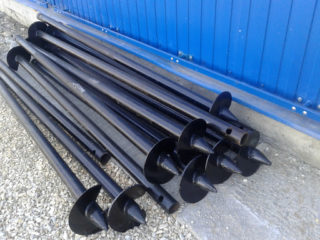
Screw piles are similar in appearance to a propeller of an outboard motor with an elongated shaft. The device of the products is quite simple, which has a positive effect on their cost and the availability of self-assembly.
Screw piles for the foundation consist of the following parts:
- Hollow metal tube. It is the shaft of the support on which functional parts are installed. Manufactured from sheet steel with a minimum thickness of 3.5 mm.
- Tip. Has a pointed side for entering the well and giving the column the desired direction.
- Blades. They have various sizes, shapes and angles. For each type of soil, separate indicators have been developed that must be taken into account when designing and manufacturing homemade piles.
- Shoe. Part of the pipe with devices for gripping, holding and screwing the pile into the ground. As a rule, after lowering the product into the ground, this part is cut off and a steel head is welded in its place.
The pile length varies between 130-260 cm. If it is necessary to increase the depth of lowering, additional links are attached to the product. For this, couplings or welding are used. The diameter starts from 55 mm and can reach 160 cm if a brick and concrete multi-storey building is being built.
Varieties of screw piles
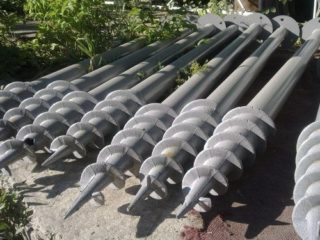
The industry produces a wide range of products that can be successfully used in private construction.
Tips on pipes can be:
- cast - represent a monolithic part, characterized by increased strength and wear resistance;
- welded - made of sheet metal, the seam is a weak point;
- open - the tip is missing, in its place is a piece of pipe with strong and sharp edges.
During the production process, the tips are welded to the barrel, the joint is ground and polished. To ensure reliable contact of parts, they are made from the same steel grades.
Piles can have the following types of blades:
- wide - have a large support area, are used for installation in peat bogs, quicksand, muddy and sandy soil;
- narrow - the blades have a more directing function, and the retention is provided by the soil with high density, hardness and stability.
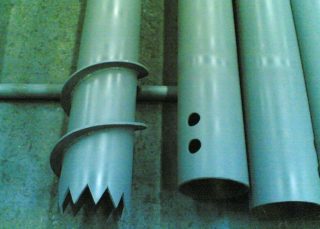
According to the number of guiding elements, piles are divided into single-, multi-blade and spiral with a minimum thread size.
Manufacturers use the following types of coatings for products against corrosion:
- polymer - strong, wear-resistant with high adhesion to metal;
- polyurethane - resistant to wear, salts and acids, temperature changes;
- epoxy - strong, inexpensive, durable, but fragile;
- cold galvanized - practical, resistant to aggressive substances, prone to detachment from iron;
- hot-dip galvanized - adhesion is better, there are restrictions on the level of acidity and soil resistance;
- paint, primer - availability of technology, ease of application, poor abrasion performance.
The type of coverage is selected based on the analysis of the composition of the soil and the presence of abrasive elements in it.
Regulations and labeling
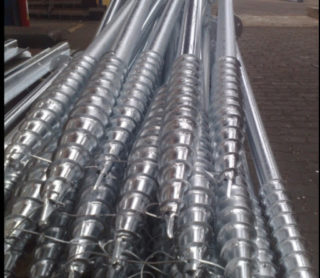
For screw piles, the following markings have been established to identify the product model:
- A helical blade pile (CBL) - has one or more sets of blades located at the tip or along the entire length of the pipe and a relatively thin barrel.
- Spiral helical pile (SHS) - consists of a barrel with a tip, one or several turns of external thread.
- Combined screw pile (SVK) is a product with a tapered or open tip. On the trunk, spirals and blades are welded in a certain order.
On the body of the product, its diameter, length, bearing capacity, indicators of acid resistance and soil resistance are indicated.
Steel for the production of piles is selected for such data as the aggressiveness of the environment, the degree of stress and installation conditions
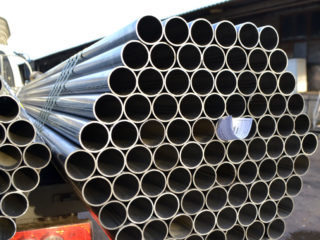
The following steel grades are used in the manufacture:
- St3 - standard medium quality carbon steel;
- St10 - high quality carbon structural steel resistant to abrasion and critically high temperatures;
- St20 - structural steel, characterized by high strength and resistance to active reagents;
- 09G2S is a low-alloy, high strength alloy for the manufacture of large diameter piles.
- 30XMA - stainless and heat-resistant steel designed for operation in conditions of high temperature, humidity and chemical activity.
It is possible to make piles with your own hands only from alloy steel, but such products will require additional efforts and costs for processing against corrosion.
Calculation of screw piles for the foundation
The main criteria are:
- bearing capacity of the product;
- type, density and saturation of the soil with water;
- depth of soil freezing;
- drove the constructed building with the furnishings brought in;
- the required service life of the facility.
The data obtained is used in modeling. The calculation can be carried out manually, but it is advisable to use developed computer programs that give the desired result accurately and quickly. At the exit, the user receives a diagram of the pile field with the immersion depth and the optimal type of grillage.
Terms of operation and scope
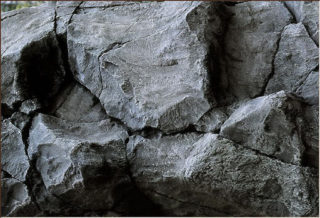
The scope of application of screw piles is limited only by the type of soil. Supports cannot be screwed into rock, the resistance of which exceeds the strength of the material. Also, you cannot screw foundation piles into the ground, where there are stones and tree roots.
It is allowed to install them as elements of a support system under such structures:
- factories, factories, hangars, bridges and other industrial facilities;
- residential buildings, administrative and utility buildings, hangars and warehouses;
- private wooden cottages, baths, frame sheds and other auxiliary buildings;
- greenhouses, premises for keeping poultry and animals;
- piers, piers, jetties, bridges over water bodies;
- supports for fences, billboards, sound protection screens along roads;
- strengthening of river banks, ravines and embankments.
The service life of products is determined by the grade of steel from which they are made, technical characteristics and operating conditions.
In accordance with the provisions of GOST 27751-2014, the following pile resource is recommended:
- temporary and seasonal facilities - 10 years;
- facilities where highly aggressive environments are processed - 25 years;
- private houses and residential buildings - 50 years;
- buildings of historical and cultural value, theaters, stadiums and high-rise buildings - 100 years old.
Before making a pile foundation, the test of the control sample is checked for compliance with the bearing capacity with the calculated data.
DIY making process
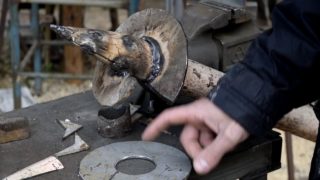
To make screw piles at home, you will need:
- roulette;
- welding;
- Bulgarian;
- drill;
- paint brush or spray gun;
- anti-corrosion agent.
Step-by-step instruction:
- make a competent drawing;
- cut out blanks from sheet metal for the blades and tip;
- make patterns from dense wood;
- give the details a given shape;
- close up the seam of the tip, weld it and the blades to the pipe;
- make holes in the barrel for twisting;
- clean the product from scale and rust.
The final step is to coat the piles with an anti-corrosion agent and dry it out. Steel frames are made if necessary.
Installation of screw piles
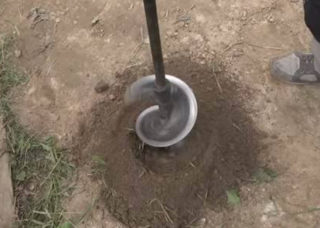
The supports can be screwed in manually or using a special technique. The choice depends on their size and quantity. Columns with small diameters (up to 60 mm) are easy to install by hand using scrap and pipes as additional leverage.
The main condition is the observance of the verticality of the support at all stages of installation. In addition, the piles must be lowered in such a way that they do not need to be unscrewed. This is unacceptable, since the density of the soil around the blades decreases, their bearing capacity decreases. After screwing in, the shoes are cut off from the trunks and the heads are welded in their place. Then all the elements are connected with a steel, wooden or reinforced concrete grillage.
Pros and cons
Like any support system, a pile foundation has its pros and cons.
Design advantages:
- applicability to almost all types of soil;
- the ability to do it yourself;
- long service life;
- stability in the ground due to the width of the blades;
- possibility of installation on a slope without prior leveling;
- installation in a close location of underground utilities;
- reusable.
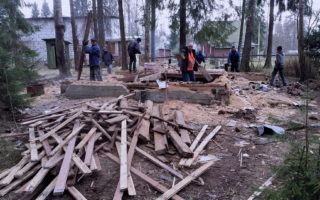
Disadvantages of the foundation:
- susceptibility to corrosion;
- limited safety margin;
- laboriousness of manual installation;
- tangible cost;
- the need for preliminary soil studies.
The right approach will create a solid and durable base.









